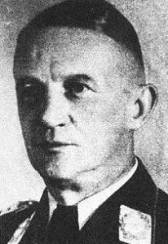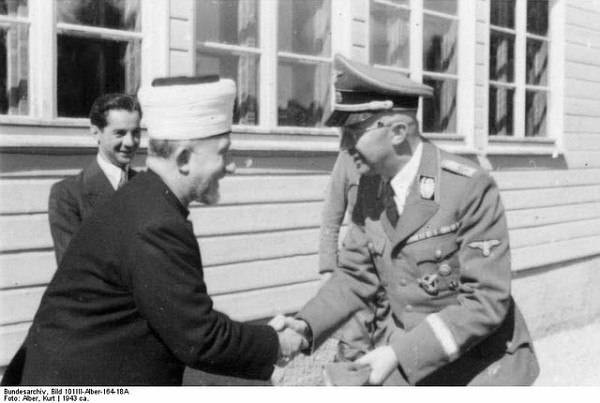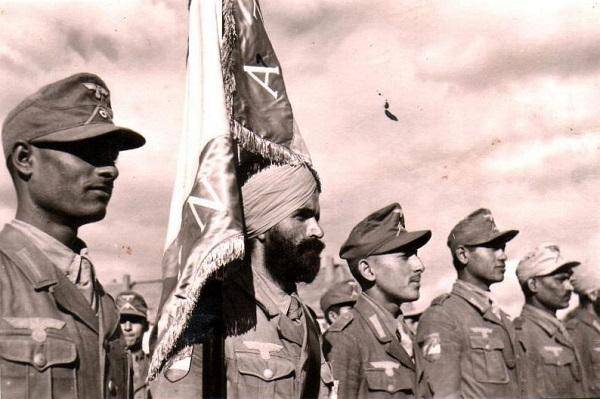The inglorious end of the body Felmy. As the "Eastern soldiers" of the Wehrmacht suffered fiasco in Kizlyar steppes
 Back in May 1941, the Special Headquarters “F” was created, headed by the Luftwaffe General Helmut Felmi (1885-1965), an experienced officer who had served in the Prussian army since 1903, and in 1912 transferred from infantry to Aviation and became a pilot, one of Germany’s recognized air aces during the First World War. In the years 1931-1935. Felmi headed the headquarters of military schools, then again moved to aviation, commanded the 2nd Air fleet, but then in 1940 sent with a special military mission to Iraq. Thus began his "eastern" military career.
Back in May 1941, the Special Headquarters “F” was created, headed by the Luftwaffe General Helmut Felmi (1885-1965), an experienced officer who had served in the Prussian army since 1903, and in 1912 transferred from infantry to Aviation and became a pilot, one of Germany’s recognized air aces during the First World War. In the years 1931-1935. Felmi headed the headquarters of military schools, then again moved to aviation, commanded the 2nd Air fleet, but then in 1940 sent with a special military mission to Iraq. Thus began his "eastern" military career. Felmy’s headquarters were assigned the task of directing intelligence, sabotage and subversive activities in the Middle East and the Caucasus. The incitement of anti-British sentiment in the Middle East and North Africa was seen as an integral component of ensuring the invasion of the Nazi troops in the region and the start of the war with the British forces.
Helmut Felmy’s candidacy for the post of Chief of the Special Headquarters “F” was not chosen by chance. The general served for a long time as a military instructor in Turkey and in Africa, and had the authority of a recognized specialist in Eastern politics. Special headquarters "F" tried to staff officers who had a real understanding of the Middle Eastern and African peoples, the political situation in these regions. Some of the officers were even professional Orientalists, but basically the backbone of the headquarters was military scouts. Major Ricks Mayer served for a long time in Turkey, Iran, and Algeria. For the "Arab policy" of the Special Staff was responsible General Grobba, who in the 1930-ies. He was a German envoy, first in Iraq and then in Saudi Arabia. The number of personnel of the Special Headquarters reached 220 people - 20 officers and 200 non-commissioned officers and ordinary Wehrmacht, who served as support. In addition, Arab nationalists who collaborated with Germany were involved in the activities of the headquarters, and their number was also only planned to increase over time. Under the leadership of German officers, Arab volunteers underwent military training in a training camp at Cape Sounion specially deployed for this purpose.
Since the main task of the Special Staff "F" was the preparation for the anti-British demonstration, the German leadership began to create armed formations that would be staffed by representatives of the peoples of the Middle East. Subordinate the regions of his power The Third Reich was going by the people of the regions themselves. Incidentally, in this, the German leaders were not original, since both Great Britain, and France, and other European colonial powers, had long relied on colonial troops, staffed by natives, in their aggressive policies. As a rule, European servicemen were in them in all officers and most of non-commissioned officers, while natives were given to representatives of the indigenous population and part of non-commissioned officers. Only some of the most fortunate members of the native elite could count on officer positions, but even then - in units fully staffed by their fellow tribesmen.
In direct subordination of the Special Staff "F" was created "288 connection", which was responsible for the actions in the Middle East. As early as July 1941, the first training unit was established, staffed by Syrian and Palestinian Arabs who studied at German universities. More than 300 Arabs, members of various nationalist groups, who were promised German citizenship and the opportunity to study in Germany, were transferred to Turkey. For military and special training of these soldiers were responsible German officers with Oriental education or experience of service in the East, who spoke Arabic. The special headquarters established contacts with supporters of the famous Arab religious and political leader Mufti al-Husseini, who adhered to radical anti-British views. Syrian Major Fawzi Kaukji, also a supporter of anti-British actions in the Middle East, arrived in Germany.

28 November 1941 was a historically important meeting between the Führer Adolf Hitler and the great mufti of Palestine, Al-Husseini, in Berlin. Mufti offered Hitler an interesting project - the creation of the "Arab Legion" as a large armed unit within the Wehrmacht, to participate in hostilities against British troops in the Middle East and North Africa. The Mufti proposed to recruit the Arab Legion at the expense of four main personnel sources: first, Palestinian Arabs who served in the British forces and were captured in Germany in the Middle East should have joined its ranks; secondly, Syrian and Iraqi officers, third, prisoners of war from the colonial units of the French army, staffed by Algerians, Moroccans, Tunisians and people from West Africa; fourthly, the Arabs who lived in France and Morocco. But the German command cautiously accepted the idea of attracting the North African Arabs, since they considered them unreliable and unsuitable for military service. It was decided to dwell on the idea of recruiting the Arab legion with Syrians, Iraqis and Palestinians.
4 January 1942 was held a meeting of the head of the Special Staff "F" Helmut Felmi with Mufti al-Husseini and the Iraqi politician Rashid al-Ghailani, who agreed to personally deal with the acquisition of the Arab Legion. Gailani planned to bring under the banner of the Nazis almost the entire staff of the Iraqi army. In addition, the possibility of speaking on the side of the Wehrmacht Arab Bedouin tribes who roamed the Persian Gulf and also extremely dissatisfied with British colonial policy was not excluded. Initially it was planned to make the Arab Legion a training unit that would allow the training of Syrian, Iraqi and Palestinian Arabs to be at least 100 lieutenants and non-commissioned officers. The first wave of recruits, after completing the training course, was supposed to train the next 500-1000 recruits herself. The junior officers and non-commissioned officers trained in the Arab Legion were considered as the basis of commanders for the further formation of armed formations and units manned by Arabs.
The German command had its own plans for the use of the Arab legion. In the summer of 1942, Operation Edelweiss began. Army Group "A" received the task of breaking through to the oil-producing areas of the North Caucasus and Transcaucasia. To participate in this operation, it was decided to use the Arab Legion, which was to receive a baptism of fire. 5 August 1942 from the camp in Greece The Arab Legion began to relocate to Bulgaria and then to Romania. On the basis of the Special Headquarters "F", it was decided to deploy the Special Purpose "F" Corps, which was to include the Arab Legion. The corps was supposed to be used as a reserve for the headquarters of Army Group “A” in the city of Stalino (Donetsk). Capturing the Caucasus, the corps was to unite in the Middle East with the German and Italian troops, who were tasked with seizing the zone of the Suez Canal. By 3 in October 1942, the transfer of parts of the corps "F" to Stalino was completed.

Corps "F" was a unique combination, which included units and subdivisions of various military branches and was able to operate almost independently. This was conceived by the Wehrmacht command - to give the corps greater mobility and maneuverability. The corps included the following units: 3 motorized battalions of 1000 soldiers and officers each (the 1st and 2nd battalions were manned by soldiers and officers of the Wehrmacht, the 3rd battalion - Iraqis, Syrians, Palestinians and North Africans), a separate tank battalion (25 tanks), aviation detachment (25 aircraft), communications company, combat engineer company, mortar company, reconnaissance armored detachment, cavalry squadron, artillery battalion of 4 batteries, 105-mm assault gun battery, 3- heavy anti-aircraft artillery division x battery, light anti-aircraft artillery division, service and support units of the headquarters and even a meteorological platoon. In addition, the corps had additional weapons, which were supposed to equip units formed from defectors of the British and French troops. The emblem of the case was also original - an oval wreath around a palm tree, the rising sun over the desert and a swastika located below, under the wreath.
The number of corps was 6 thousands of people, but then he was given additional forces, including a cavalry regiment and tank battalions. The special tasks facing the corps suggested increased attention to the quality of the training of soldiers, non-commissioned officers and officers of the formation - not only military but also ideological training. Even German soldiers and non-commissioned corps officers should have mastered one of the Eastern languages - Arabic, Turkish, Farsi, etc. In turn, the soldiers recruited from representatives of the Middle Eastern peoples, without fail, learned German - to facilitate communication with German colleagues and command. Special attention was paid to the study stories and ethnography of the Near and Middle East, North Africa. The command of the Wehrmacht approached the question of strengthening the corps very seriously, considering it as the vanguard of the advancement of German troops in the countries of the Near and Middle East. The corps personnel had to not only fight, but also prepare anti-British uprisings in the East, carry out reconnaissance and sabotage activities in the countries of the Near and Middle East.
However, in October 1942, Army Group A suffered significant losses in the battles with the Red Army. In this regard, it was decided to throw to their aid fresh parts from the reserve, including the Felmy corps. The first battle of the corps forces with the Red Army occurred on October 15 1942, north of Achikulak. Here parts of the corps were to fight with cavalry units of the 4 Guards Kuban Cossack Cavalry Corps. The command of the Transcaucasian Front sent units of the 4 Guards Kuban Cossack Cavalry Corps under the command of Lieutenant-General N. Ya. Kirichenko in the steppe area to cover the Kizlyarsko-Astrakhan railway. The corps march began along the Nogai steppe - from Terekli-Mekteb and further towards Achikulak. The cavalry was moving under the cover of Soviet aviation. However, on October 10-12, units of the 4 corps were attacked by Hitler’s 1 tank tanks. But the Germans could not resist the Red Army - the Kuban Cossacks defeated the enemy’s units and took several settlements.
The actions of the Soviet troops in the North Caucasus are beautifully described in the existing military history literature. It should be noted here that the Cossacks-cavalrymen of the 4-th Guards Kuban Cossack Cavalry Corps, and the 5-th Guards Cavalry Corps that joined him, under the command of Major-General A.G. Selivanova showed themselves extremely well. They completely "broke" all the plans of Hitler's command. General Helmut Felmy hoped that the destruction of the railway tracks by the aviation forces would deprive the Cossacks of supplying food, as a result of which they would be forced to retreat. But Felmy was wrong. The compound of General Kirichenko was able to drop the enemy and come forward. In these battles, the 10 Guards Rifle Corps of Major-General V.V. Glagolev, 5-th Guards Don Cossack Cavalry Corps, Major-General A.G. Selivanova. Although the actions of the F corps were supported by attached tank, motorized, and cavalry units of the Wehrmacht, this part of the German army, which was considered elite, was never able to offer serious resistance to the advancing Soviet forces. As a result of the fighting in this sector of the front, Corps F suffered the most serious losses and was actually defeated by the advancing Soviet troops. The plans of the Hitlerite command to use the corps in the further advancement to the south - in the Transcaucasus and further to the Middle East, turned out to be completely untenable.
In the fighting in the area of Achikulak, the corps "F" suffered a crushing defeat. In this situation, the command of the Wehrmacht decided to withdraw it from the combat zone. In January 1943, the corps was reorganized - it again became known as Special Headquarters "F", which indicated the failure of its use in hostilities. The remains of the corps in February 1943 were evacuated by aircraft from the territory of the Soviet Union to North Africa - to Tunisia. So ingloriously ended the epic of "Eastern Warriors" Adolf Hitler on Soviet soil. Hundreds of military corps were in Soviet captivity. Interestingly, the Soviet officers were very surprised captive Arabs. First of all, communication with these prisoners was difficult, as many Arabs, especially from the rank and file, despite the German courses, were unable to communicate with Soviet military translators.
In the end, the corps commander, General Helmut Felmy, who had fought on the territory of Yugoslavia by the spring of 1945, surrendered to the allied forces. He was arrested and sentenced to 15 years in prison at the Nuremberg Tribunal. Then his sentence was reduced to ten years, and in 1951, he was released. Helmut Felmy died in 1965 in Darmstadt at the age of eighty.
Information